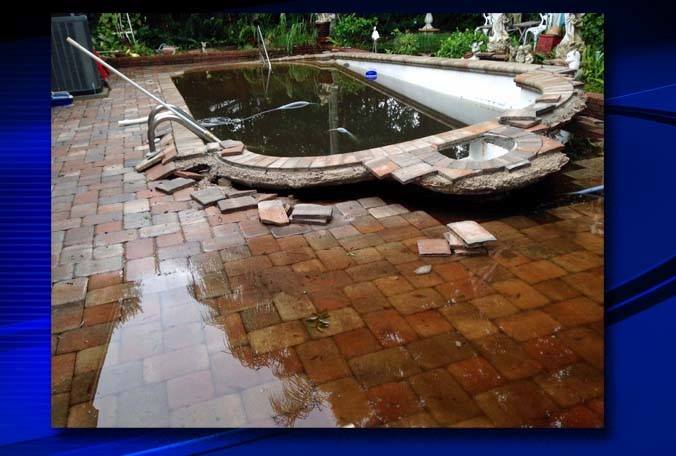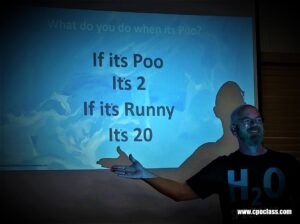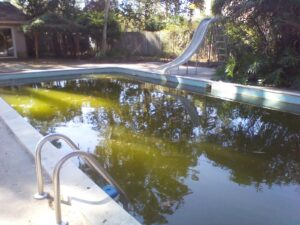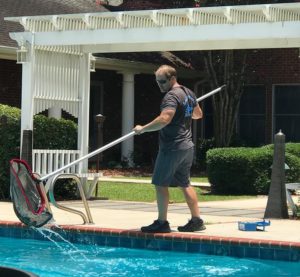The water level is down. It’s either a problem, or it’s not a problem. How do you know for sure? Before running around like a wackadoo on the streets shouting ‘Oh Crap, the pool is leaking! There is a couple of easy, low to no-cost steps to find a pool leak before you empty your wallet.
[responsivevoice_button voice=”UK English Male” buttontext=”Listen to Post”]
Your first instinct should NOT be to call a leak detection service. They are expensive, and rightfully so – they offer a specialty service within a specialty market. The truth is they don’t want you to waste their time either. It would really suck to shell out a service fee’s cost to have someone tell you the loss is normal and due to evaporation.
Water Test Results!
I suggest you immediately head for your test kit. There can be many reasons for the levels of certain things to drop, but there are two values we check that will only drop due to a leak. Of course, this depends upon your diligence in testing what you should be testing on the reg. If any of the bottles in your test kit are still full, you may be SOL on this method.
Taylor K2005 Swimming Pool Chlorine Bromine Alkalinity Hardness pH DP Test Kit.
Calcium Hardness (CH) and Cyanuric acid (CyA) can only be lowered by replacing water. You may lose some due to splash out, drag-out, or backwashing, but usually not enough to make a significant difference. If you did not physically drain water from the pool and your homeowner or facility personnel did not drain it, and the CH and CyA levels have dropped, the pool must be draining on its own.
Find Pool Leak or Chase Evaporation
You can easily lose an inch or two of water a week due to evaporation alone. Heck, in some of the Southern and Southwestern states three to four inches in a week is not unheard of. However, if water had been lost due to evaporation (the other possible culprit in a plummeting water level), the calcium hardness and cyanuric acid levels would not decrease.
Only water leaves the pool in evaporation; everything that was in it is left behind. Then when topped off, the CH level would increase, and the CyA would remain the same. If you have an autofill, you might not notice a water level difference as it would continually replace what is lost. Conducting a complete water test periodically may be your only indication that the pool leaks.
Bucket Test!
A bucket test is another means of differentiating between a leak and evaporation you can do at no cost. Unless you don’t own a bucket, I have never met a pool pro or aquatic professional who didn’t. Still, a trip to the big box DIY and an orange Homer will do nicely.

First things first, if you have an auto-fill, turn it off. Next, fill the bucket with enough pool water that the level in the bucket is only enough higher than the level in the pool to keep it from floating around when placed on the top step. Add a short strip of electrical tape to mark the pool water level outside the bucket. Another short strip to mark the level inside the bucket. A permanent marker does not write well on a wet bucket, so I prefer the tape.
similar article How and When to Install Wellpoints
Leave the bucket and pool undisturbed. If after 24 hours the water in the pool has dropped more than the water in the bucket – the pool leaks. You find the water in the bucket has dropped the same amount as the water in the pool – evaporation is to blame. If you find that the water in the bucket has dropped more than the water in the pool – one of your co-workers is screwing with you.
Don’t Drain the Pool!
Water will eventually seek the level of the leak and stop. So, this method can help in locating at least how far down it could be. If the level stops at the bottom of the skimmer, question the integrity of the skimmer. If it stops at the return, the leak is likely at that point. However, there is the concern of imminent danger should the leak be in the pool’s bottom.

The hydrostatic relief valve is in the sump and is not immune to failure – this would cause the pool to lose water from its deepest depth. If you allow the pool water level to drain too low in your attempt to find a leak in our ‘water will seek the level’ approach, the entire pool can easily pop up from the ground. If you consider attempting this ‘leak and destroy’ measure, I would strongly advise not to let the water level dip below the skimmer. If your pool pops from the ground, it will be super expensive, and you’ll be hating life.
Drop Deck!
If you notice a section of the deck has dropped to the point, it resembles a New Jersey sidewalk, that can pinpoint the area. I’d love to tell you that it is just one section rising. Unfortunately, it is just the opposite. A leaking wall, pipe, fitting, white good has flushed out the sand beneath the deck in that area, causing the concrete section to drop—end of story.
Dye Test!
A dye test can help check around white goods such as your return jets or skimmer, even around a light fixture. These come in a syringe and are available in several colors. It is best to use dark-colored dye in light-colored pools and light-colored dyes in dark.
SWIMMING POOL LEAK DYE TESTING SYRINGE: Pro service Kit.
There is a miscibility gap that allows the coloring not to dissolve immediately. This is advantageous as we can watch the pattern in the pool. The dye will be drawn with the water flow through whatever fissure is causing the loss, providing the pool is leaking in that area.
Air Leaks
Suction side leaks in plumbing do not result in a loss of water; of course, this is with one exception. Pressure side leaks will usually drip the entirety of the time a system is running. Monitoring air bubble patterns through the return fittings can help us to determine where to look. A continuous stream of bubbles the entirety of the time the system is running points toward suction. Bubbles that subside after the system has run for a couple of hours point toward pressure.
Leak Detection Service
You can only check what you can check, and you should only fix what you are qualified to fix. Winging it is not how we get experience; working with someone experienced is how that is done. If you have ruled out evaporation as the cause of the disappearing pool water trick and you either cannot find the leak or are not licensed (where required), insured, or proficient in the needed repair, it’s time to call someone who is. Contact a pool professional who specializes in leak detection, or contact a leak detection service.
Follow us on Facebook Click Here

Advanced Swimming Pool Water Chemistry Certificate








I like how you mentioned that if you are seeing a significant difference, it is time for leak detection. My cousin mentioned to me last night that he is planning to have their swimming pool checked due to leaks and asked if I have any idea what is the best option to do. Thanks to this informative article and I’ll be sure to tell him that it will be much better if we consult a trusted pool leak detection service as they can answer all our inquiries and will provide good-quality service.
I am glad the article was helpful – Thank you for reading!